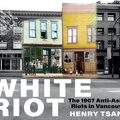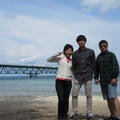Read Part 1 >>
Can you briefly describe the work you did to link the Alaskan fishermen with those in Tohoku?
In 2011, I helped the BC fishing industry identify two fishing communities to support with their direct donations. After seeing how slow donation money can flow, and hearing so many rumours about large amounts going to organizations’ overheads and not to the victims, I am a firm believer and supporter of direct donations. If you can find someone to trust, then it is the best way in a disaster.
In my instance, I was able to identify by interviewing and taking photos of different fishing-based losses along the coastline and giving this information to BC, and then eventually to the Alaska fishing group for their consideration.
From the files that I sent, they chose the fishing villages and sent money directly to the villages, and not through me. I insist that I can look around for who is in need, but I do not like to handle money. This is up to the donor to do once they have decided.
Out of the 10 large donations that the Alaska AFIRM group (Alaska Fishing Industry Relief Mission, Inc.) made to Tohoku fishing villages, nine were ones that I had recommended. All the fishing villages that I identified were given money except for a fishing high school that made their application long after the deadline (but this school has an established exchange program with Hawaii, so they will hopefully get help).

One of the Alaska donations provided much needed safety equipment to Tohoku fishermen who were trying to get back to some fishing...without such safety, in order to help get their families and communities back on their feet.
How much of a difference is this making?
In total, about $300,000 went directly to fishermen. The number of fishermen and family members that this money has benefited is mindboggling. I have the figures, but not off hand and want to get this sent to you. The impact dollar for dollar has been huge and the impact emotionally has been even greater.
The Tohoku fishing people are so overwhelmed that other fishermen that they do not know and come from another country, care about them and donate money to get them back into the waters.
What kind of assistance is still needed?
Tons. I do not know where to begin answering this question but perhaps beginning on the worst threat that faces all of us is the nuclear disaster. What can we all do about that for our future?
Do you know that the Toronto JCCC collected more than $1 million for Tohoku Tsunami relief that they plan to use for a scholarship fund for young people?
Wonderful idea…
At the moment, there is a small scholarship that will spread as the money comes in.
It is by a water company in Kagoshima who was one of the local (for Kagoshima exhibition) sponsors of the “Cloth Letters” project exhibition in Kagoshima. When becoming involved as a sponsor of the “Cloth Letters,” they decided to become more
active in helping young people in Tohoku so, they made a bottled water called “WE LOVE JAPAN.”
Ten percent of their sales go to this scholarship, but it is an undetermined amount, so I helped them begin the scholarship in Otsuchi, Iwate, because it was one of the hardest hit towns with so much damage and deaths. Scholarships go to any high school student’s entrance exam fees for any university. Some of these exams are expensive, depending on university.
Once they succeed in their entrance, they can get some help from government loans or bursaries. The high school student must be a tsunami victim and it should also include directly affected (lost their homes) as a result of the nuclear plant fallout in Fukushima.
I was able to set up a person who is well established in Otsuchi, to help the high
schools administer the scholarship. As more “WE LOVE JAPAN” water is sold, the scholarship would spread to other towns down the coastline.
So much has been happening with you since the 3-11 tsunami last year. Can you bring us up to date on what has been happening with the cloth letter project?
The “Canada Tohoku Japan Cloth Letters” is just finishing the exhibition in Fukuoka. After Fukuoka is Niigata. Niigata will end the national Japan Tour.
The Japan national tour has run for over one year since the first formal exhibition held at the Canadian Embassy October 13 to December 13, 2011; the Japan national tour ran from December 2011 to mid-November 2012; the Tohoku Tour 2012 runs from mid-November 2012 to December 31, 2012.
Many cities with their mayors, throughout Japan supported exhibitions of the Cloth Letters., e.g. Kobe, Obu, Onomichi, Osaka, Nagasaki. Other locations were supported by community groups or universities in Nagoya, Hiroshima, Kagoshima and other locations.
Soon, the Cloth Letters will begin their final leg of the time in Japan with the launch of the Tohoku Tour on November 19 in Minamisinriku after which it will be in Minamisoma and other locations in Tohoku.
The grand finale exhibition will be Otsuchi, Iwate ken, the location in Tohoku that suffered the greatest damage and deaths from the tsunami/earthquake. The details of the opening/closing ceremony are being worked on now.
At the end of December, the cloth letters will be prepared for shipment back to Canada.
What has been surprising is the continued interest and support of the project in Japan and elsewhere. (Canada is slowest). It is also surprising how many locations still want to make their cloth letters and join this project. For instance, next week two junior high schools in Sendai begin making their “Sendai” Cloth Letter.
And the medical students at Aichi Medical University in Nagoya have been having workshops at their university for the student doctors and patients want to make a “Nagoya” Cloth Letter. They sent me a facebook link with some of their cloth letters. I heard that they have made over 200 individual cloth letters!
© 2012 Norm Ibuki








